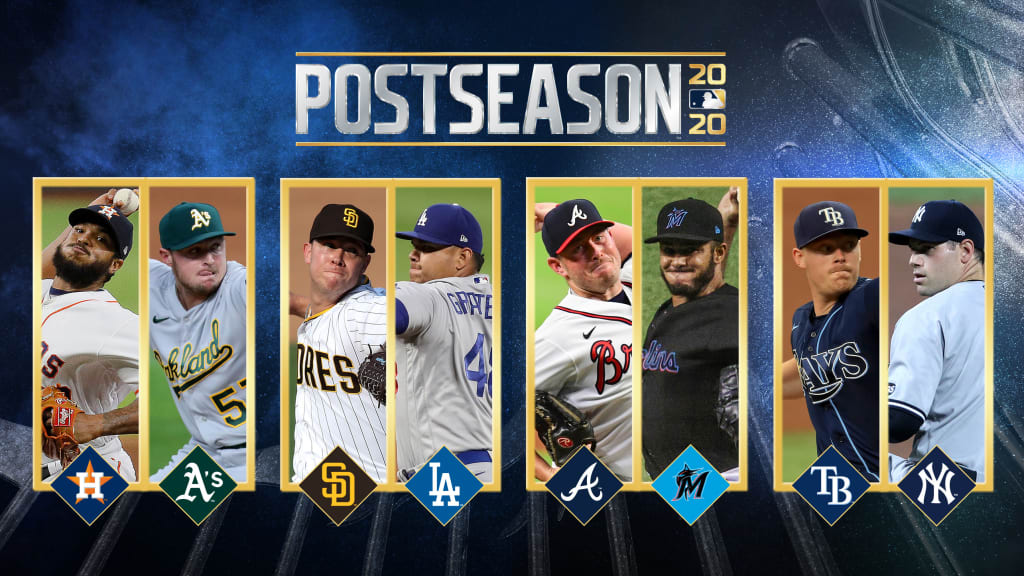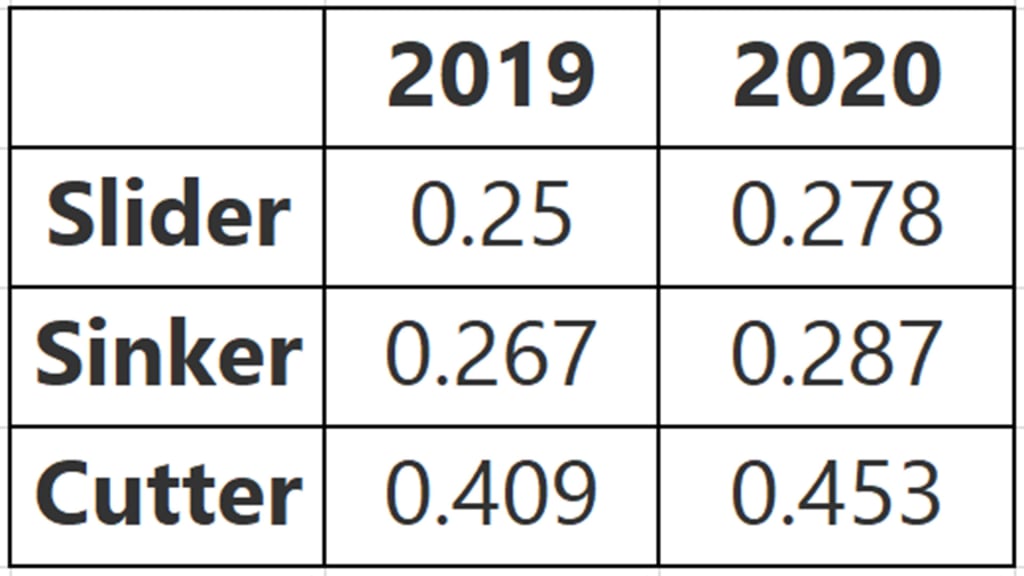
When it was announced that the League Division Series and League Championship Series would not have any off-days this year, the first, natural thought was that this means teams will, in all likelihood, need more than three solid starting pitchers to survive.
But it also means they will, in all likelihood, need more than one guy who can close out games or, at the very least, be trusted in high-leverage spots. In the 2017 World Series, Dodgers manager Dave Roberts used Brandon Morrow in every one of the seven games, with diminishing returns in the Series and, as it turns out, in Morrow’s career.
So let’s look at some non-closers who could swing the upcoming Division Series in one direction or the other. These guys may or may not see save opportunities, but their work will be important.
Astros: Josh James, RHP
Houston was able to piece things together in the two-game sweep of the Twins in the Wild Card Series with starters Framber Valdez and Cristian Javier providing long relief. But that formula probably won’t work in a longer round.
James, therefore, looks to be an important piece. He and acting closer Ryan Pressly were the only non-rookie relievers rostered by the Astros in the opening round. James showed a lot of potential in striking out 14.7 batters per nine, predominantly in a relief role last season. But the big stage proved a bit too big for him in the ALCS and World Series last year because of his walk troubles. Those troubles continued with two bad starts early in this 2020 season and subsequently after moving back to the bullpen. But James finished the season with six scoreless innings during which he walked just one batter.
A's: J.B. Wendelken, RHP
The A's great closer Liam Hendriks threw 68 pitches in the last two games of the White Sox series, inspiring manager Bob Melvin to call him “Hercu-Liam.”
Oakland will obviously need more than “Hercu-Liam” to keep going and has the deep bullpen (whose 2.72 ERA was the best in the AL) to do it. We could pick several options from this 'pen, but Wendelken was second only to Hendriks in innings pitched (25), with a 1.80 ERA to boot. And fresh off a brief stint on the injured list for unspecified reasons, he had 3 2/3 scoreless innings in the Wild Card Series. Wendelken rates well above average in fastball velocity and spin, average exit velocity and hard-hit rate.
Braves: Tyler Matzek, LHP
While the Braves’ starting rotation was a hot (and injured) mess in the regular season, the bullpen was generally phenomenal. This, despite key offseason acquisition Will Smith having more trouble than anticipated (3.9 homers per nine). It was another lefty, Matzek, who stepped into some key setup situations in front of closer Mark Melancon. The 29-year-old is a fantastic story, having overcome the yips and a five-year absence from the Major League stage to become a valuable bullpen piece on a contender (2.79 ERA, 1.92 fielding independent pitching mark in 29 innings).
The key question is whether Matzek can be called upon on back-to-back days. He hasn’t done that yet this season, and his performance on one day of rest (.778 opponents’ OPS) was not as strong as when he was more rested. A more frequent usage pattern might be unavoidable in the NLDS.
Dodgers: Brusdar Graterol, RHP
Despite Kenley Jansen's inconsistency and drop in cutter velocity (his 88.1 mph average in Game 1 of the Wild Card Series was the lowest of his career), Roberts said before Game 2 of the Wild Card Series that Jansen is “absolutely” still the closer. Uh, you sure about that, Dave? Because mere hours later, it was Graterol brought in to protect a 3-0 lead in the ninth inning against the Brewers, and the rookie came through.
So while it might be a slight bend of the “non-closer” rules, we’ll go with Graterol here, though veteran Blake Treinen might be just as likely to see save situations moving forward. Whatever the role, Graterol -- who is only on the Dodgers because the trade that was supposed to send him from Minnesota to Boston fell through -- has a lot of appeal, with a 99 mph sinker that he offsets with a highly effective slider. The stuff, though, hasn’t matched up with the stats in terms of strikeouts. Graterol’s 14.8 strikeout percentage is among the lowest in MLB. Despite this, Graterol, with a 0.90 WHIP, has shown he can get big outs, and he justified Roberts’ use of him in that big spot against the Brewers. We’re likely to see a lot more of him moving forward.
Marlins: Yimi García, RHP
The bullpen was not a strength for the Fish this season, but, as we saw in the Wild Card Series sweep of the Cubs, García and closer Brandon Kintzler have emerged as an effective one-two punch. With some questions about the depth of this group overall, the Marlins will continue to trust two of their more experienced arms in high-leverage spots.
Non-tendered by the Dodgers last winter, the 30-year-old García responded with a 0.60 ERA and 19 strikeouts against five walks in 15 innings in the regular season. It was no fluke, because his expected weighted on-base average (.252) and hard-hit percentage (30.6) were both strong. He made four appearances on zero days’ rest and allowed only a single run in the 3 2/3 innings covered in those outings.
Padres: Emilio Pagán, RHP
The Padres also have Drew Pomeranz to set up or fill in for closer Trevor Rosenthal. But Pomeranz’s iffy injury history, including a shoulder strain earlier this year, means manager Jayce Tingler must be careful not to overuse him.
Pagán, who a year ago was closing for a terrific Tampa Bay bullpen, is a go-to option in tight spots and can be used on back-to-back-to-back days, as proven when he threw 30 pitches in Game 1 of the Wild Card Series, 11 in Game 2 and 19 in Game 3 (throwing three scoreless innings along the way). His season got off to a rough start, but he had a 2.03 ERA and .514 opponents’ OPS in his final 13 1/3 innings. His numbers against right-handers (.158/.233/.342 opponent slash) could come in handy if the Padres need a big out against Mookie Betts or Justin Turner.
Rays: Pete Fairbanks, RHP
Nick Anderson is the club’s closer, but the Rays have a variety of guys they can turn to in high-leverage spots, Fairbanks among them. If you’ve never heard of him until reading his name right here, you are well within your right. That’s how the Rays roll. They have, as manager Kevin Cash put it, a “stable of guys who throw 98 mph” that come up, come in and get outs.
Fairbanks had a 6.43 ERA as recently as Aug. 10, but in his last 20 outings of the regular season, he had a 1.37 ERA and a fantastic .194/.301/.264 opponents’ slash, striking out nearly one-third of batters faced in that span. He pitched a scoreless inning in Game 1 of the Wild Card Series. His fastball velocity, whiff percentage and expected opponents’ slugging percentage are all in the 90th percentile or higher, and he’s shown an ability to be effective (2.25 ERA) on zero days' rest, which is important to keep in mind in this format. Fairbanks could even be an opener option (he did it twice this season) if the series goes deep.
Yankees: Adam Ottavino, RHP
I wrote why the Yankees, despite their No. 5 seed and subpar season, are not to be underestimated. But it’s no secret that the bullpen is the element that can bring the whole thing down. It was supposed to be a strength, but a season-ending injury to Tommy Kahnle changed the calculus a great deal, as did Ottavino’s disastrous 5.89 ERA in 18 1/3 innings. This on the heels of his struggles last October. It was notable that in a big spot in Game 2 of the Wild Card Series, manager Aaron Boone went with Jonathan Loaisiga over Ottavino.
But with up to five games in five days in the Division Series, Ottavino is going to have his number (No. 0, that is) called eventually, and perhaps he can still deliver. He had a 10:1 strikeout-to-walk ratio in his last 5 2/3 innings (albeit in low-leverage spots), and Statcast tells us his opponents’ expected weighted on-base average on his slider, sinker and cutter weren’t terribly dissimilar from his 2019 season (when he had a 1.90 ERA in 66 1/3 innings):


